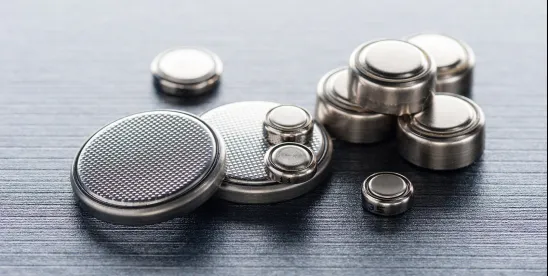Over the past year, manufacturers, importers, distributors, and retailers of consumer products containing button cell and coin batteries (or products intended to contain them) have continued to adapt to the requirements of Reese’s Law and the Consumer Product Safety Commission’s (CPSC) corresponding enforcement efforts.[1]
Passed by Congress in August 2022, Reese’s Law is intended to protect children and other consumers against the hazard of ingesting button cell or coin batteries.[2] Reese’s Law applies to “consumer products,” as defined by the Consumer Product Safety Act (CPSA),[3] manufactured or imported on or after March 19, 2024, that contain, or are designed to use, a button cell or coin battery.[4] The requirements of Reese’s Law largely fall into two categories: (1) labeling requirements for the products themselves and packaging; as well as (2) “performance requirements” related to how the product itself secures its battery.[5] A discussion of Reese’s Law can be found here with some common FAQs found here.
As detailed below, a few recurrent themes have emerged over the past year with respect to Reese’s Law. Businesses that manufacture, import, distribute, or sell consumer products utilizing button cell and coin batteries should take immediate action to ensure those products are compliant.
Reese’s Law Noncompliance Has Already Been the Source of CPSC Reports and Recalls
Compliance with Reese’s Law is a top priority for the CPSC. Instead of pulling back on enforcement (as seen in other areas of the federal government in recent months), the CPSC has shown that it remains committed to ensuring compliance with Reese’s Law.[6]
To date, noncompliance with Reese’s Law has resulted in several recalls, affecting a wide variety of products, including infant swings, firearm accessories, “smart” patio doors, and submersible RGB LED lights. The violations prompting these recalls run the gamut, including for example, failing to adequately contain the batteries making them accessible to children, and/or failing to include the required labels on the products themselves or their packaging. Many such recalls address both performance and labeling violations.
Businesses should immediately report to the CPSC when they become aware of a potential violation or instance of noncompliance with Reese’s Law. Reporting any potential violations is consistent with the duty that all manufacturers, distributors, importers, and retailers have under Section 15(b) of the CPSA—i.e., the duty to report when a consumer product fails to comply with applicable consumer product safety requirement, such as Reese’s Law.[7]
Compliance May Be Difficult in Certain Circumstances
Reese’s Law provides stringent labeling and performance requirements for consumer products that contain button cell or coin batteries (regardless of whether the batteries are included or sold separately).[8] These requirements can necessitate significant investments of time, money, and other resources to ensure proper compliance.
1. Labeling Requirements
As to labeling, Reese’s Law requires precise labeling on both a covered product’s packaging and the product itself (with some limited exceptions).[9] Compliance may require significant revamping of a covered product’s packaging to include required warning labels and even retooling the manufacture of a covered product itself to include on-product warnings. Even stricter requirements apply to a covered product sold with button cell or coin batteries themselves (i.e., batteries included), rather than by itself, without batteries included.[10]
The CPSC’s recent activity with respect to Apple’s AirTags for noncompliance with the labeling requirements of Reese’s Law are a prime example of labeling enforcement.[11] In its press release announcing an agreement with Apple, the CPSC wrote that Apple had modified both the product itself and the product’s packaging to display the required warnings, and that Apple had taken further action to remediate noncompliant units already sold to consumers.[12] The CPSC concluded its press release with a reminder that manufacturers, importers, distributors, and retailers must report noncompliant products to the CPSC immediately.[13]
2. Performance Requirements
Reese’s Law also includes several “performance requirements” including that consumer products containing button cell or coin batteries must secure the battery inside the battery compartment in such a way that the battery is not exposed or released during reasonably foreseeable use or misuse to minimize the risk of ingestion.[14] For example, a covered product must be able to endure a certain amount of force or tension applied directly to the product, and also be able to withstand drops from certain heights, all without the battery breaking free of the battery compartment.[15] Best compliance practices often include working with a third party testing laboratory to confirm product compliance. Should such testing reveal noncompliance with Reese’s Law for a covered product already in the stream of commerce, it could trigger an obligation under the CPSA to report to the CPSC.[16]
What Does This Mean for My Business?
Complying with Reese’s Law should be top-of-mind for all manufacturers, importers, distributors, and retailers of consumer products containing button cell or coin batteries. Businesses that manufacturer, importer, distribute, or sell covered products should take immediate action to ensure their products comply with the requirements, including consulting with experienced counsel as appropriate and acting on their duty to report any noncompliant products to the CPSC. Additionally, ensuring compliance will require such businesses to coordinate with their suppliers and incorporate these requirements into their annual compliance reviews or audits to identify and correct any compliance gaps.
[1] Safety Standard for Button Cell or Coin Batteries and Consumer Products Containing Such Batteries, 16 C.F.R. § 1263 (2023).
[2] Reese’s Law, 15 U.S.C. § 2056e.
[3] See Consumer Product Safety Act, 15 U.S.C. § 2052(a)(5), which defines a “consumer product” as “any article, or component part thereof, produced or distributed (i) for sale to a consumer for use in or around a permanent or temporary household or residence, a school, in recreation, or otherwise, or (ii) for the personal use, consumption or enjoyment of a consumer in or around a permanent or temporary household or residence, a school, in recreation, or otherwise” with limited exemptions.
[4] See Notes to Reese’s Law, 15 U.S.C. § 2056e (A product is covered by Reese’s Law if it is “[1] a consumer product [2] containing or designed to use one or more button cell or coin batteries, regardless of whether such batteries are intended to be replaced by the consumer or are included with the product or sold separately.”); see also 16 C.F.R. 1263.2.
[5] See Button Cell and Coin Battery Business Guidance, Consumer Product Safety Commission, https://www.cpsc.gov/Business–Manufacturing/Business-Education/Business-Guidance/Button-Cell-and-Coin-Battery.
[6] See Recalls & Product Safety Warnings, Consumer Product Safety Commission, https://www.cpsc.gov/Recalls.
[7] Consumer Product Safety Act, 15 U.S.C. § 2064(b)(2).
[8] Notes to Reese’s Law, 15 U.S.C. § 2056e; see also 16 C.F.R. 1263.2.
[9] See 16 C.F.R. §§ 1263.3, 1263.4 (2023).
[10] Section 3 of Reese’s Law imposes further requirements on the sale of button cell or coin batteries themselves—specifically that the packaging in which such batteries are sold must comply with the Poison Prevention Packaging Act (PPPA). See Button Cell and Coin Battery Business Guidance, Consumer Product Safety Commission, https://www.cpsc.gov/Business–Manufacturing/Business-Education/Business-Guidance/Button-Cell-and-Coin-Battery; see also 16 C.F.R. 1700.15 (regulation implementing the Poison Prevention Packaging Act).
[11] CPSC Secures Agreement with Apple for Enhanced Warnings to Protect Children from Hazards of Battery Ingestion; Apple Takes Action to Address Labeling Violations on AirTags, Consumer Product Safety Commission, https://www.cpsc.gov/Newsroom/News-Releases/2025/CPSC-Secures-Agreement-with-Apple-for-Enhanced-Warnings-to-Protect-Children-from-Hazards-of-Battery-Ingestion-Apple-Takes-Action-to-Address-Labeling-Violations-on-AirTags.
[12] Id.
[13] Id.
[14] 16 C.F.R. §§ 1263.1(a), 1263.3 (2023).
[15] See id.
[16] Consumer Product Safety Act, 15 U.S.C. § 2064(b)(2).






 />i
/>i

